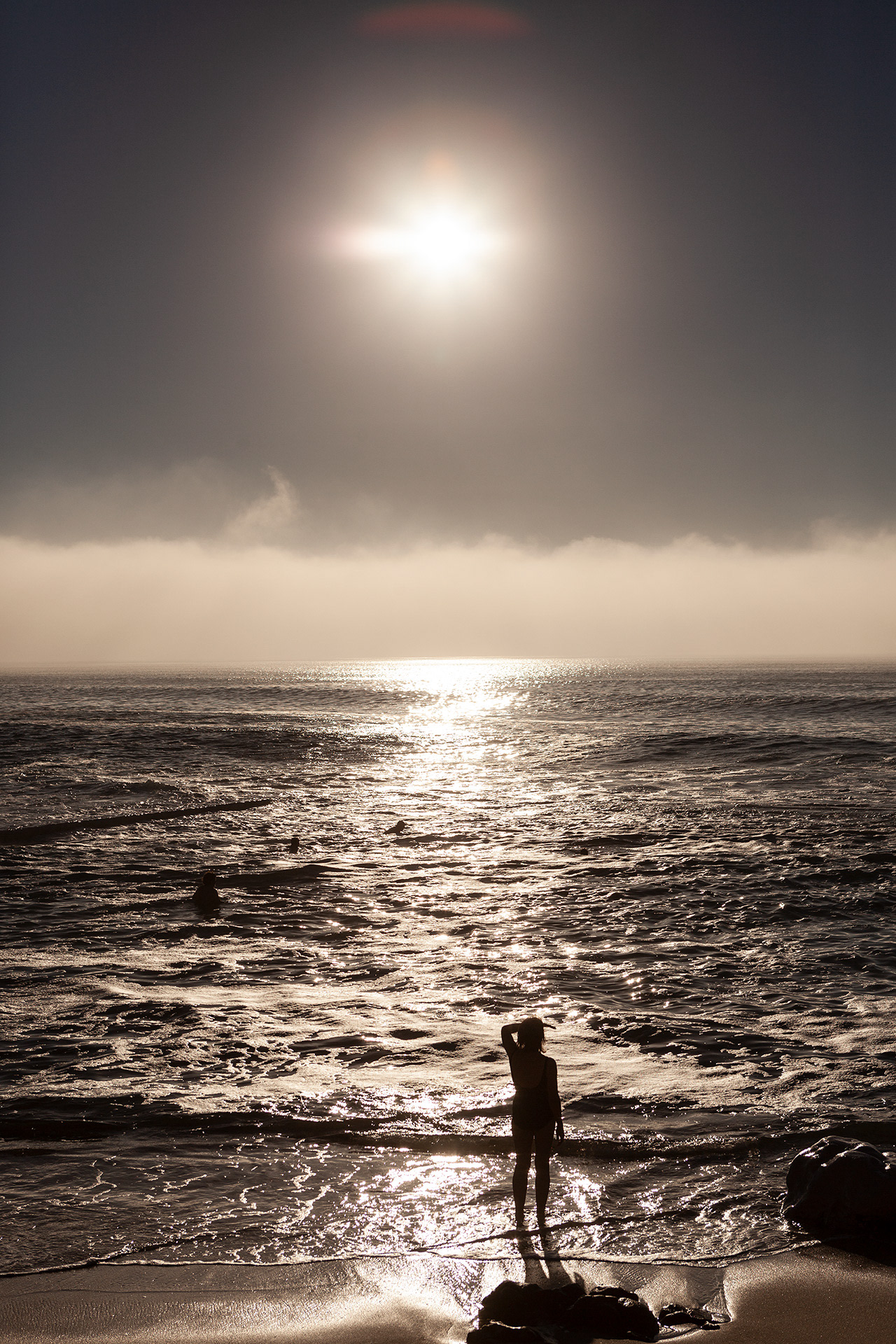
Back From The Brink - Muizenberg (Cape Town)
Copy and Photography by Alfred Lor
Commissioned and Published by The Property Magazine, Cape Town
The lifeguard sitting up on Boyes Drive, wearing red shorts, spends his day searching for sharks in the waters off Muizenberg beach. Down below are about a dozen surfers looking for good waves, a thousand screaming kids, a few litres of (not so waterproof) factor 33 sunblock floating on the surface and some really huge women wallowing in the shallows. Frankly, the sharks should be scared.
Muizenberg has been attracting crowds for decades. Hippies, yuppies, Rastafarians, surfers, students, hordes of young children and their mothers' domestic workers, are all here. The mix of people is colourful and eclectic, with none of the snobbish cattle parade seen on some Cape Town beaches. People-spotting on Muizenberg beach is like a satisfying main course, as opposed to Sandy Bay's titillating starter portions. The sand is clean, the water a delicious turquoise and warmer than along the Atlantic seaboard.
Together with Blue Flag coordinator, Allison Kelly, Cape Town City Council officials granted Muizenberg Blue Flag pilot phase status for 2005. The Blue Flag is given to beaches that have superior amenities, cleanliness and environmental and safety standards.
There is work to be done before full Blue Flag status can be granted, but the False Bay Tourism and Business Association is planning to have all the necessary requirements in place before the end of the year.
Muizenberg, unfortunately, has been famous for more than its beach and recreational facilities. Once a prestigious seaside town and a retreat for the well-heeled, it became a sad and derelict shadow of its former self as urban decay set in during the late 1960s. The seasonal tourism that the area depended on dried up and the increasing number of absentee landlords eventually created a vacuum that was filled by undesirable residents.
There is change in the air though. The bergies and druggies are moving out and developers are moving in. Muizenberg is waking from a long hibernation. Ironically, while this period of slumber has not been good for the local economy or its civic-minded residents, it has been instrumental in preserving aspects of Muizenberg's former glory. Beautiful old buildings that may have been knocked down to make way for ugly apartment blocks – had the area been thriving – have quietly survived and are now protected by The Historic Society. Those that have historic significance may now be renovated and rejuvenated by developers, but not demolished.
The famous Majestic Café, situated in the Majestic Mansions on Beach Road, opened its doors in 1937. I am a regular customer – love the burgers but avoid the sweaty hotdogs under the glass counters beneath the ?s Coca-Cola posters and photographs of early Muizenberg. I adore the building with its garish red and white-trimmed façade and zigzag detail, gloriously lacking in subtlety and introspection.
The Balmoral next door is a more sophisticated old lady. Although less showy than the Majestic Mansions, she is elegantly exquisite. Her symmetry is perfect and the beautiful arches are mirrored in the surfboard balconies.
The Muizenberg Civic Centre opposite the Balmoral is a testament to the diversity of architecture found in Muizenberg. It is not pretty, but the pure absurdity of its ?s Pop Art-style roof makes it an inexplicably essential part of Muizenberg's structural landscape and a popular landmark.
The buildings fronting the beach are inspiring, magical and slightly surreal. You can almost see the pink Cadillacs that pulled up bumper to bumper outside these buildings back in Muizenburg's golden days. This strip has been a favourite for film crews wanting to capture scenes from days gone by. The art deco façade of the Empire Building is exquisitely weathered – for now.
One Tuesday last April, demolition started on the buildings lining the beachfront. A group called the Muizenberg Village Developers decided to make the dream of a rejuvenated Muizenberg a reality. The initial stage of the development will see the long derelict Empire and Greens buildings transformed into residential units with underground parking and shops and restaurants on ground level. Enclosed squares will extend the outdoor space of the beachfront and offer respite from inclement weather.
David Kretzmar of the Muizenburg Village Developers enthuses: 'We are totally committed to this project, which has been long overdue. It is not just a development, but a regeneration of an entire suburb, which forms an integral part of the history of Cape Town.'
The 120 apartments will range in price from R599 000 for one-bedroom units to R3-million for top end three-bedroom units.
I fell in love with the Empire the first time I saw it, and was horrified to hear it was being demolished. But my fears were unfounded. The main façade of the building will be restored to its original grandeur, while the remaining façades will be developed to reflect elements reminiscent of the original architecture.
Architect Derek Henstra worked closely with the Heritage Foundation and Historic Society to retain the character and original form of the building. The developers have ensured that the height of the new structures will not exceed that of existing buildings in the area and will blend seamlessly into the historic landscape.
Most people are familiar only with Muizenberg's lively and eccentric beachfront. There is, however, a whole world of colour, energy and personality in the village itself, a melting pot of socio-economic and ethnic diversity that is hard to miss if you take a quick walk around.
Harry, who works in the film industry, has lived in Muizenberg for 16 years. His home, a beautiful old house painted bright purple on Hansen Street, has wireframe cows attached to its roof and is adorned with signs proclaiming it to be the Apollo Café. Down the same road is a house that has been decorated with shoes, loos and old, bald Barbie dolls.
Then there are Camilla and Henk, a young professional couple who bought their house nine months ago. Months of painting, sanding, varnishing and fixing transformed their slightly neglected older home into a triumphant blend of modern living and seasoned character.
The people of Muizenburg, despite their peculiarities, are just as involved with the current rejuvenation as the developers. Established homeowners have quietly been cleaning up and renovating their properties, while new investors have been buying up derelict homes and evicting undesirable tenants. The board and directors of the Muizenberg Improvement District (MID) have been proactive in the struggle for a cleaner, safer Muizenberg. Machteld van Lennep, manager of the MID says: 'Muizenberg is in a much better condition than it was four years ago when the MID first started and ratepayers have experienced significant rises in the value of their properties.'
Projects undertaken by the MID include the organising of security services and street cleaning. It also endorses the Living Hope project that rehabilitates vagrants and assists the homeless under the auspices of local radio station, CCFM.
Ratepayers are starting to reap the rewards of their vision and commitment towards a better Muizenberg. While property prices soar, delis, boutiques and restaurants are popping up all over the place. According to Margo Nadler of Cape Coastal Property Group, prices have generally doubled in the last year. The greatest demand in the village is for properties going for under R800 000 – typically two- to three-bedroom terrace houses in fair to good condition.
At the top end of the market, period homes in the village with three to four bedrooms, double garages and flatlets are going for between R1-million and R1.5-million. Houses situated on the mountainside overlooking Muizenberg and the ocean are fetching up to R2.5-million.
People buying in Muizenberg include young professionals and entrepreneurs, artists, families with children, retirees and investors. The reasons people find Muizenberg attractive are varied. Some are attracted to the lifestyle that comes with living so close to the beach, vlei and mountain.
The cosmopolitan feel, Old World charm and architecture are drawcards for others. I have heard homeowners likening parts of Muizenberg to the backstreets and alleys of Paris or Milan.
Rochelle Bomberg, a well-known and respected artist found the area irresistible due to its value for money. Her home, Windemere House, is a magnificent art deco structure, complete with turret, winding staircase and incredible detailing. The property, which serves as home, studio and gallery, cost a mere R700 000 in August 2003 and is now valued at around R1.7m.
It is not only the village of Muizenberg that is on the up and up. Nearby Marina Da Gama with its clean white Mediterranean style architecture and network of shimmering waterways sells itself on lifestyle, rather than character. Those who wish to paddle after work without the hassle of transporting their canoes to water need look no further.
Neighbouring Capricorn Park is a 68ha commercial and clean industry park. Launched in 2000, it had a slow start due to the decline in the IT industry. Now the tide has turned and more than 30 sites have been sold in the last six months, under the new management of the Rabie Group.
Cape residential property developers Amdec have recently launched a village-style development called Fisherman's Haven. Situated just outside Muizenberg, the village will ultimately consist of 200 homes designed in a nautical style by architect Hannes Bouwer.
Ranging in size from 60m² to 110m², they will be priced from R600 000 to R1.2-million and, according to Jayne Hendry of Sotheby's International Realty, will offer the best coastal property buy on the entire False Bay coastline.
The walk between Muizenberg and St James is stunning and one I tread regularly. Crashing waves fill the air with sea spray and the occasional train rumbles past as you meander alongside some of Cape Town's most historic buildings. The first and oldest is the Posthuis. Once a drop-off point for sailors on their way to and from the east, it is now a museum housing historical artifacts and collections of amusing anecdotes.
The Natale Labia, the SAPS museum, Rhodes Cottage and Yokohama (the papier maché house) all feature on the stretch between Muizenberg and St James, but don't get too distracted as there is a good chance that you'll spot whales as you stroll. The trail ends at the St James tidal pool, handily close to the St James Station. The train line between Muizenberg and Simonstown is spectacularly scenic, and provides a great way to get around when the roads are clogged with sunseekers.
I stayed in Muizenberg when I first moved to Cape Town, in a beautiful old home, typical of the houses in Muizenberg village. It had high ceilings, stained-glass windows, Oregon pine floors and big sturdy burglar bars. In the house next door a group of fanatically religious types kept to themselves while across the street a bunch of smiling and not at all sinister guys from central parts of Africa, ran an informal but prosperous pharmaceutical business.
The 'pharmacists' are now gone. A trendy looking young couple bought the house and are busy ploughing love and money into it. Muizenberg is coming full circle. The grandeur and majesty that seemed lost is now being found.
Part of the charm for me has always been in its faded opulence and withered richness. I am excited and happy about the change and positive growth but, I confess, part of me will sometimes miss the simmering, steaming character and delectable diversity that despite the bad press was, after all, mostly harmless.
